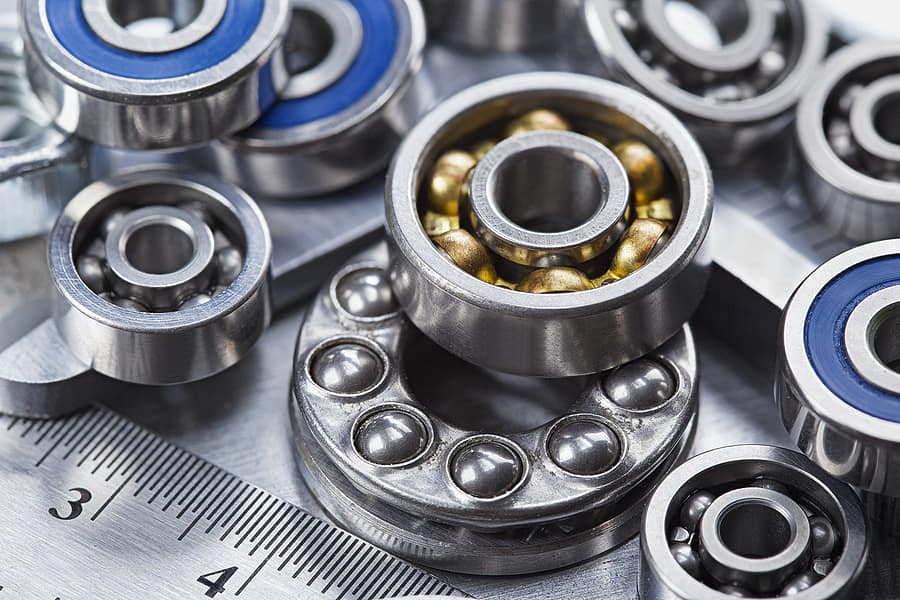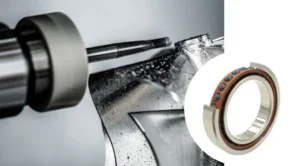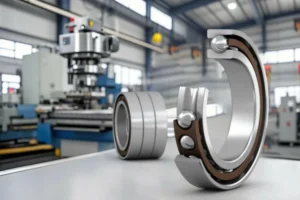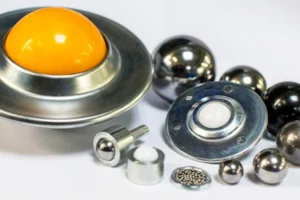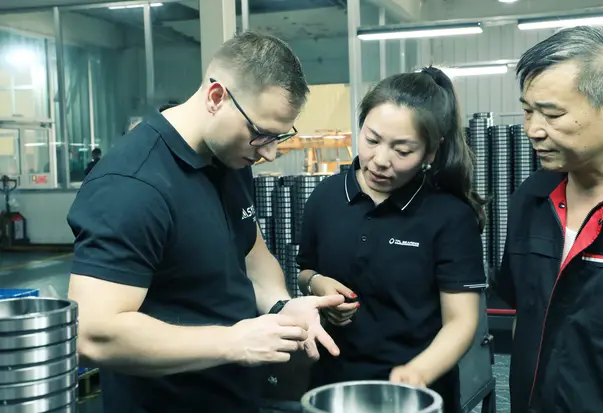Introduction
Have you ever noticed that the blade of a pair of scissors becomes dull when exposed to the elements for a long time? Rusty scissors always have difficulty cutting things. Similarly, if your bicycle chain is not maintained, it will become stiff after a rain. At this time, the bicycle will not only make a shrill sound, but also be extra hard to pedal.
The culprit for these phenomena is rust.
The same is true for bearings. Rust on ball bearings will not only affect the smooth operation, but may even lead to the scrapping of bearings and equipment downtime.
Lubrication is an effective way to reduce rust. So what is the best way to lubricate ball bearings? Let’s explore.

The purpose and importance of ball bearing lubrication
As we all know, when two objects that are in contact and squeeze each other move or tend to move relative to each other, friction will be generated on the contact surface. In engineering technology, people use a series of lubrication methods to reduce friction.
The principle of lubrication, in simple terms, is to reduce friction and wear by forming a lubricating film between the contacting surfaces.
For ball bearings, there are tiny contact points between the rolling elements (such as steel balls) and the raceways. Under high-speed rotation or high load conditions, these contact points will produce intense friction. Lubricants can form a lubricating film between these contact surfaces to isolate the metal surfaces and reduce direct friction.
Proper lubrication can reduce heat generation while preventing corrosion and contamination. In this way, the service life of the bearing can be extended and the operating efficiency can be improved.

Types and selection of lubricants
Grease
Grease is a thick, oily semisolid. It is mainly composed of three parts: thickener, base oil, and additives. Generally, the thickener content in grease is about 10%-20%, the base oil content is about 75%-90%, and the content of additives and fillers is less than 5%.
Grease has low fluidity and is not prone to leakage. The oil film formed by grease has good strength, which is more conducive to the sealing of ball bearings. At the same time, grease lubrication of ball bearings can also extend the lubrication maintenance time, making bearing maintenance simpler.
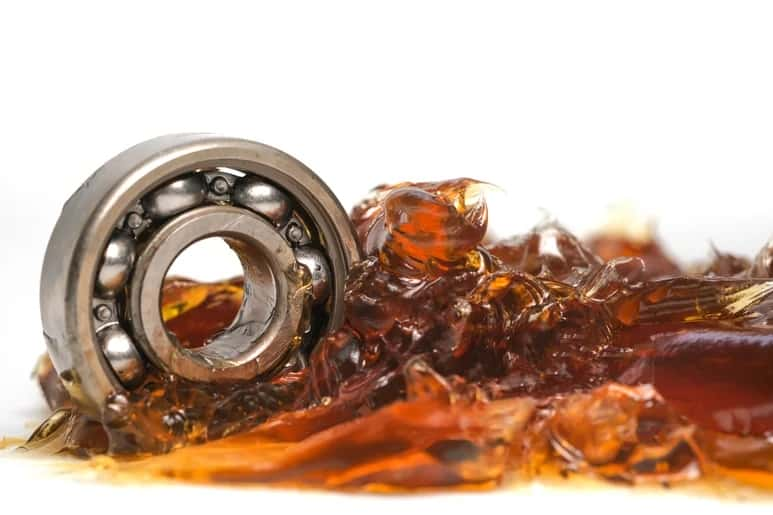
Advantages of grease lubrication
- Simple lubrication device. If sealed bearings or non-sealed bearings that do not require grease replenishment are used, no additional lubrication device is required (in contrast, oil lubrication systems require oil pumps, oil pipes, oil tanks, etc.).
- Grease is not easy to leak, and the sealing structure of the bearing is relatively simple.
- The maintenance and care of the bearing are convenient.
- Grease has a sealing effect, which can prevent external dust, moisture and other impurities from invading the bearing.
- It is easy to improve the cleanliness of the mechanical device.
Disadvantages of grease lubrication
- The bearing has large friction, poor heat dissipation, and the allowable speed is relatively low.
- The dn value of grease-lubricated bearings generally cannot exceed 3×105mm·r/m·n.
- When the temperature is very high, the base oil of the grease will accelerate evaporation and oxidation deterioration, and the colloidal structure of the grease will also change and accelerate oil separation.
- For every 10℃-15℃ increase in bearing temperature, the life of the grease decreases by 1/2. Except for special high-temperature grease, general grease cannot be used at high temperatures.
Lubricating oil (Oil)
Lubricating oil consists of a base oil, which establishes its basic properties, and additives. These additives are crucial for improving the base oil’s performance deficiencies and bestowing it with new qualities.

Advantages of oil lubrication
- Strong heat dissipation capacity. Lubricating oil can effectively remove the heat generated by bearing friction during circulation, which helps to maintain the bearing at a suitable operating temperature.
- When the lubricating oil flows, it can wash away the wear debris and impurities inside the bearing to maintain the cleanliness of the bearing.
- The fluidity of the lubricating oil enables it to effectively lubricate at high speeds, and it can adapt to higher operating temperatures through additives.
- The liquid film of the lubricating oil can provide a certain damping effect, absorb vibration and impact, and reduce noise.
- For large machinery or complex systems, lubricating oil can be transported, filtered and cooled through a centralized oil supply system, which is easy to manage and maintain.
- The lubricating oil can be enhanced by adding various additives (such as anti-wear agents, extreme pressure agents, rust inhibitors, etc.) to meet the needs of different working conditions.
Disadvantages of oil lubrication
- Lubricating oil is liquid and easy to leak, so a more complex sealing design is required to prevent contamination and insufficient lubrication.
- Lubricating oil needs to be checked and replaced regularly, and its viscosity is easily affected by temperature changes, resulting in unstable lubrication effect.
- At extremely high speeds, extreme temperatures or high pollution environments, the lubricating oil may not provide sufficient lubrication and its performance is easily affected by pollutants.
Comparison table between grease and lubricating oil
| Comparison Item | Grease | Lubricating Oil |
| State | Semi-solid, paste-like, low fluidity | Liquid, high fluidity |
| Composition | Base oil + thickener + additives | Base oil + additives |
| Main Functions | Lubrication, sealing, rust prevention, gap filling | Lubrication, cooling, rust prevention, cleaning, sealing, damping |
| Adhesion | Strong adhesion, stays in place, resists dripping | Weak adhesion, prone to dripping or leakage |
| Temperature Range | Wider working temperature range | Narrower working temperature range |
| Load Capacity | Higher load capacity, stronger oil film, shock resistance | Lower load capacity |
| Cooling Ability | Poor heat dissipation, higher internal friction | Good heat dissipation, suitable for high speeds |
| Typical Applications | Enclosed systems, low-speed heavy loads, intermittent lubrication | High-speed, high-temperature systems requiring continuous lubrication and cooling |
Lubrication method
Grease lubrication method for ball bearings
Manual greasing
- Method: Inject grease into the lubrication points of the bearing or bearing seat through a grease gun or manually.
- Applicable scenarios: Suitable for equipment with low speed, medium speed or intermittent operation, with a long maintenance cycle.
- Features: Simple operation, but grease needs to be replenished regularly, suitable for small equipment or low-frequency maintenance scenarios.

Centralized lubrication system
- Method: Grease is delivered to multiple bearing points in a timely and quantitative manner through a centralized lubrication system (such as an automatic lubrication pump).
- Applicable scenarios: Large machinery or industrial equipment with multi-point lubrication, such as bearings on production lines.
- Features: High degree of automation, uniform lubrication, suitable for continuously running equipment.
Sealed lubrication (lifetime lubrication)
- Method: The bearing is pre-filled with grease during manufacturing and sealed with a seal or dust cover, and grease does not need to be replenished.
- Applicable scenarios: small motors, home appliances, automotive wheels and other long-term maintenance-free scenarios.
- Features: No additional maintenance is required, but the grease life is limited, suitable for low-load, low-speed or medium-life equipment.
Lubricating oil lubrication method of ball bearings
Oil bath lubrication (oil pool lubrication)
- Method: The bearing is partially immersed in the lubricating oil pool, and the oil is brought to the friction surface by rotation.
- Applicable scenarios: vertical or horizontal bearings with low to medium speeds, such as reducers.
- Features: Simple and economical, but the oil level needs to be controlled to avoid excessive overheating or leakage.

Drip lubrication
- Method: The lubricating oil is supplied to the bearing in the form of drops through an oil drip device (such as an oil cup).
- Applicable scenarios: small or lightly loaded bearings, such as small motors or precision machinery.
- Features: The amount of lubricating oil can be controlled, suitable for low-speed or intermittent operation, but the oil level needs to be checked regularly.
Splash lubrication
- Method: Use rotating parts (such as gears) to splash the lubricating oil onto the bearing surface.
- Applicable scenarios: Bearings coaxial with gears in gearboxes or closed systems.
- Features: No additional lubrication device is required, suitable for medium-speed equipment, but the lubrication effect depends on splash efficiency.
Circulating oil lubrication
- Method: The lubricating oil is delivered to the bearing through an oil pump, and is recycled after filtering and cooling.
- Applicable scenarios: high-speed, high-temperature or heavy-load equipment, such as large motors and turbines.
- Features: Good heat dissipation effect, reusable lubricating oil, suitable for continuous high-load operation.
Oil mist lubrication
- Method: The lubricating oil is atomized into fine particles and sprayed onto the bearing surface through compressed air.
- Applicable scenarios: high-speed precision bearings, such as machine tool spindles.
- Features: Small amount of lubricating oil, good heat dissipation and cleaning effects, but special equipment is required.
Spray lubrication
- Method: The lubricating oil is directly sprayed into the friction area of the bearing through a high-pressure nozzle.
- Applicable scenarios: ultra-high-speed bearings, such as aircraft engines or high-speed turbines.
- Features: It can effectively cool and lubricate, but the system is complex and the cost is high.
- Replenishment and replacement of lubricants
Replenishment interval of grease
The expected life of grease is affected by many factors. For example, the type of grease, the speed and temperature of the bearing, the amount of dust and corrosive gas in the working environment, the design of the sealing device and the actual performance of the bearing.
For sealed or smaller bearings, either the bearing itself or the grease in it determines the life of a set of bearings. It is not necessary and impossible to add or replace grease in the middle.
Empirically, the grease replenishment interval is halved for every 15°C rise in bearing outer ring temperature exceeding 40°C.
Replacement cycle of lubricating oil
When the rolling bearing is working, do not use too much oil, just enough to maintain a layer of oil film. If too much oil is added, it will cause the temperature of the lubricating oil to rise too high, accelerating the oxidation and deterioration of the lubricating oil.
For high-speed rolling bearings, in order to ensure the need for heat dissipation, sufficient lubricating oil should be supplied, and a circulating lubrication system should be set up for lubrication and cooling (heat dissipation).
The replacement cycle of lubricating oil is determined by the working conditions of the bearing, environmental conditions, oil volume and type of lubricating oil. Generally, when the operating temperature is below 50℃ and the oil is used in a good environment with little dust, it should be replaced once a year. When the oil temperature reaches 100℃, it should be replaced every 3 months or less.
Common lubrication errors
Using the wrong lubricant category
Different bearing types and operating conditions (such as speed, temperature, and load) require different types of lubricants. For example, high-speed bearings require low-viscosity oils or greases, while heavy-loaded bearings may require high-viscosity or extreme-pressure greases. Incorrectly using non-extreme-pressure (non-EP) greases instead of extreme-pressure (EP) greases, or vice versa, can lead to lubrication failure.
In addition, mixing different lubricants can lead to ineffective lubrication. Different brands or types of lubricants (especially greases) may not be compatible, and mixing them will cause lubricant performance to deteriorate. Worse still, different lubricants may react chemically to form harmful substances, accelerating bearing wear and failure.

Over-lubrication or under-lubrication
Excessive grease increases stirring friction inside the bearing, causing temperature increases, which in turn accelerates grease oxidation and deterioration, shortening its life. In high-speed applications, over-lubrication can cause bearing temperatures to rise sharply or even cause burning. In addition, excessive grease may overflow from seals, causing equipment contamination and even posing safety hazards (such as in the food processing industry). When lubricant is insufficient or loses its lubricating properties, metal surfaces will come into direct contact, resulting in increased friction and wear. This process generates a lot of heat, which can cause bearing overheating, discoloration, raceway and rolling element scratching, sintering, and even seizure, which ultimately leads to premature fatigue failure of the bearing.
Improper lubricant supply intervals
Many people choose to perform lubrication maintenance on fixed dates for ease of operation. This is wrong because the operating conditions, type, speed, load, and environmental factors of the bearing are changing. For example, the operating conditions of the bearings are different in different seasons, and the lubricant loss is different. If relubrication is performed on a fixed date, there is a high probability of over-lubrication or under-lubrication. The lubrication interval should be based on the type and operating conditions of the bearing. You can follow the manufacturer’s recommendations to accurately grasp the best time for lubrication.
In addition, grasping the lubrication interval also requires predicting or estimating the service life of the lubricant. Lubricants (especially greases) have their service life. If the lubricant is not replaced or replenished for a long time, the lubricant will lose its lubricating properties due to aging, even if the initial filling amount is appropriate.
Incorrect lubrication operation
Lack of cleaning is a common problem. Bearings, grease holes and seals may contain contaminants such as old grease, iron filings, machining debris, etc. In addition, the tools used can also cause contamination. For example, if the tip of a grease or grease gun is not cleaned or protected with a cap after use, these contaminants may be injected directly into the bearing.
Conclusion
A large portion of bearing failures are related to lubrication problems. Just as the body needs healthy blood circulation, bearings also rely on high-quality lubrication to maintain their vitality. Ignoring lubrication is like ignoring the body’s warning signals, which will eventually lead to irreversible damage and costly downtime.
Choosing the right lubricant, taking the right lubrication method, controlling the right amount of lubrication, and strictly following the cleaning operation specifications – these are the core elements to avoid premature bearing failure.
As a professional ball bearing manufacturer, TFL is well aware of the importance of factory lubrication. During the manufacturing and assembly process of each of our ball bearings, they are strictly pre-filled or initially lubricated with high-quality lubricants that perfectly match the characteristics of the bearing.
Excellent initial lubrication is only the first step. For your TFL bearing to continue to operate efficiently, proper subsequent maintenance is also critical. We are very happy to provide you with professional lubrication and maintenance guidelines to help you maximize the service life and performance of your TFL bearings. Contact our expert team now to equip your equipment with TFL bearings and create value continuously and stably!
